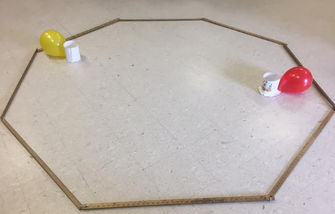

They struggled with the task for a couple of days, but eventually a student rolled his Play Dough into two parallel snakes instead of balls. By jumping the LEDs from one snake to the other and connecting the snake’s ends to the battery, they had discovered the difference between wiring in series and in parallel.
Next we learned to drive Spheros, the programmable balls popularized in the Star Wars movie. After learning how to control them, the students designed covers for them out of tag board. A balloon was attached to the back and a straight pin to the front. Then they battled each other in an octagon made of meter sticks.
In our most recent build, students studied the principles of hydraulics. Then they used popsicle sticks, syringes, and tubing to construct battling arms. Their goal was to knock their opponent off the table.
No behavior problems, no off-task behavior. Just hard-working students engaged in the fun of learning. All without grades. How is this possible, don’t students need the motivation of grades to learn?
I’m not certain of the answers to these questions, and I think more formal research is needed, but I have some ideas based on my observations. First of all, I had to ask myself why we grade in the first place. Obviously we are trying to document and quantify learning. But I suspect that we already know who is learning in our classes and who is not.
When we give an assessment, we typically can guess who will do well and who will struggle. We also know of students in our class who bright and are learning but do not necessarily have grades that reflect that. So grading is often done after the fact in a sense as it reinforces what we already knew. Any teacher already has their hand on the pulse of the class anyway.
Sometimes we use grades as a motivation. Students who value their grades will stirve to get the A and learn in the process. I was that sort of student. It did not occur to me that the purpose of learning was to grow and satisfy our insatiable brains. For me, learning occurred as a byproduct of my pursuit of good grades.
But here was an entire class that was working and learning without grade motivation. Some of the students in my elective were also in my math/science class and were very grade motivated. This leads me to suspect that when learning is presented in a brain-palatable format, the external motivation of grading is not necessary. In fact, some of the students who I knew were learning the most were getting Fs in their other classes due to a lack of work.
This makes me suspect that perhaps the educational process has become synthetic. By that I mean that the way we help brains grow and learn does not fit its natural design. Think about it; we teach reading through engaging books, not by studying the dictionary. Yet math and science are often studied via text-based approaches instead of by engaging applications, causing many students to ask the question they do not ask in other content areas: “When are we ever going to use this?” That’s a question that is never asked in PE class. To this day, I remember the excitement of learning to do a back flip on a trampoline in high school even though I have never needed to do a back flip during a job interview.
This experiment has left me asking myself, “How can I engage my students’ brains more effectively?” As our school ends its third year as a STEM center, I believe I’m inching toward the answer.
Happy teaching,
Brad
 RSS Feed
RSS Feed